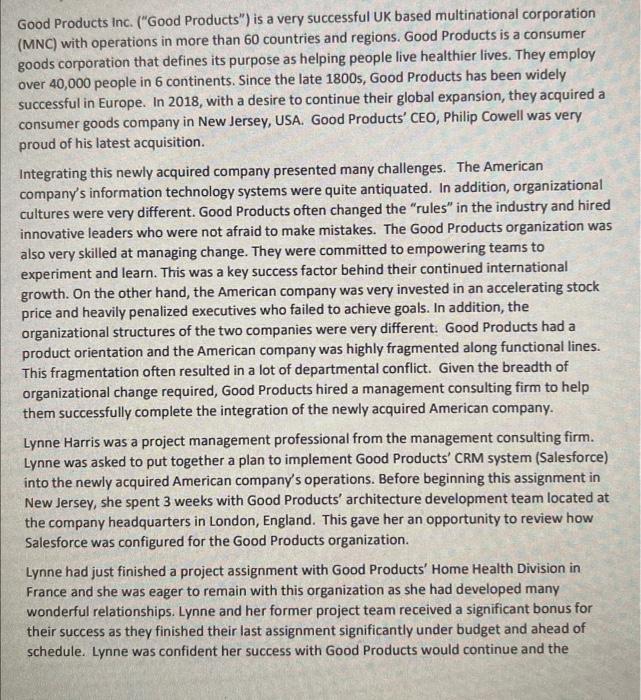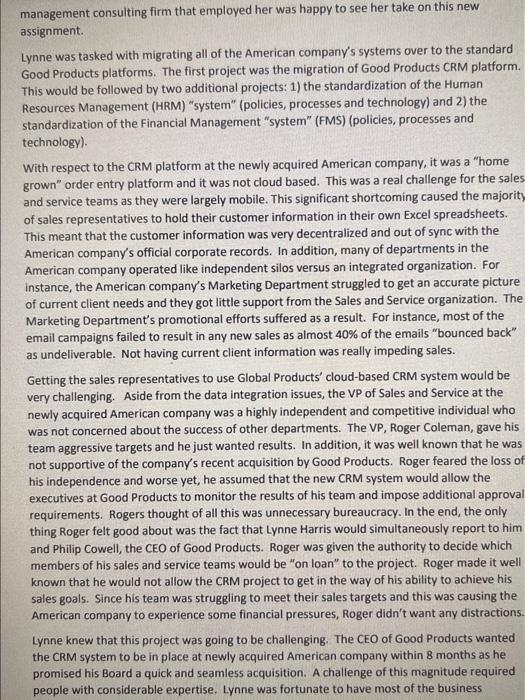the case study part 1 and part 2 are given below.
WBS IS GIVEN BELOW
Project Schedule
Use Goods Company Inc. HRM Standardization Project. This WBS will serve as your starting point. Further, we will use this WBS to understand how the primary project constraints (scope, schedule and cost) are linked together and help us establish the baselines for our project. With the scope baseline already created, the objective of this task is to create the schedule baseline. Were determining how long it will take to deliver this projects scope. In other words, were building the projects schedule.
Here's the summary of the steps required:
1. Create the structure of your schedule
2. Estimate the durations of the work
3. Sequence the work
4. Add milestones
5. Assign human resources
6. Identify the projects critical path Detailed instructions:
1. Create the structure of your schedule Use WBS to create the structure of your schedule in MS Project.
2. Estimate the duration of the work Recall the estimating techniques in use today. We commonly look for similar projects that were conducted in the past and adjust the durations for the circumstances of our current project.
Since you dont have the ability to rely on past projects, I will not be critiquing the individual estimates you make. However, your schedule must have a total project duration of 120 days (this is 6 months assuming there are 4 weeks in a month and 5 working days in a week). This duration applies to all 3 projects in our Case Study.
3. Sequence the work Some of the deliverables cant be started until others are finished. We refer to this as dependency relationships. As you build your schedule, consider the nature of the work being performed. Also, recall that project management work occurs throughout the project so be sure to sequence this work appropriately. Create at least 5 logical dependencies in the MS Projects predecessor column.
4. Add milestones
Milestones are markers that help us determine if were on track. They signify the completion of a major deliverable.
In determining your milestones, think about the work you would want to celebrate with your team and the communications you would have with stakeholders about major accomplishments.
Recall that the milestones you add are included in the requirement to have at least 50 lines in your schedule.
5. Assign human resources We want clear roles and responsibilities on our project. This is critical in getting work done.
Assume you have a team of at least 10 people.
Create a resource sheet using role names like Senior Analyst, Junior Analyst, Project Manager, Project Coordinator and Trainer. Ill leave it to you to research 5 more common role title in project delivery
. Identify the capacity they will have to work on the project and assign a reasonable hourly rate
. Ensure all the tasks in your schedule have a resource assigned.
6. Identify the projects critical path The critical path is the series of activities that drive the projects completion date. They allow us to effectively manage our newly created schedule. Use the softwares functionality to highlight the series of the activities that determine the projects completion date.
Additional task Notes:
1. Your task includes three parts:
a) Your modified WBS, if required. (PDF format is acceptable)
b) Project File (mpp format; NOT a PDF)
c) Screen Shot which shows your full name as shown below:
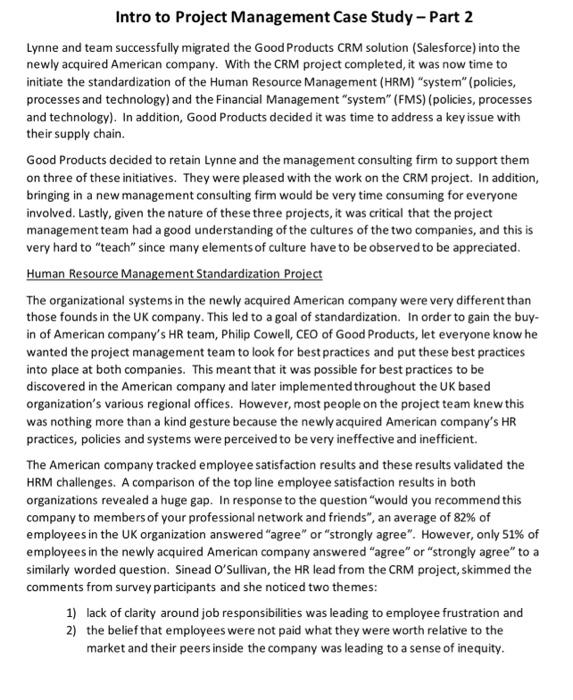
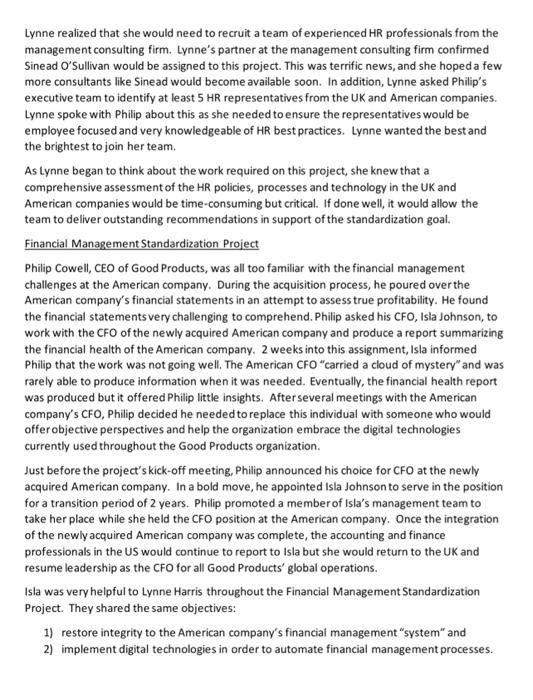
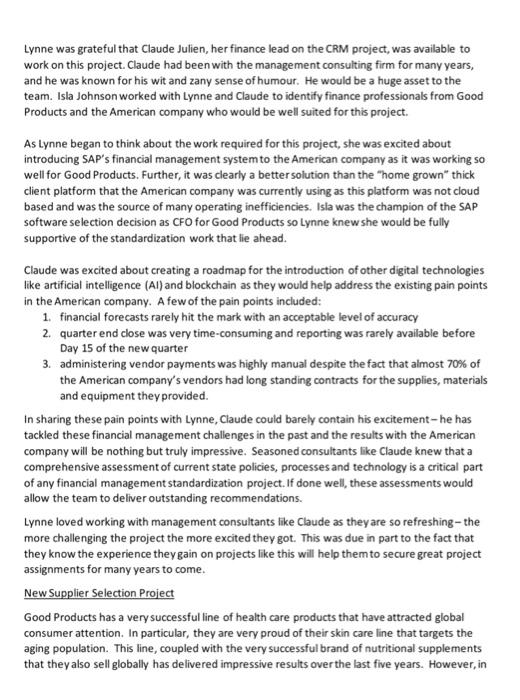
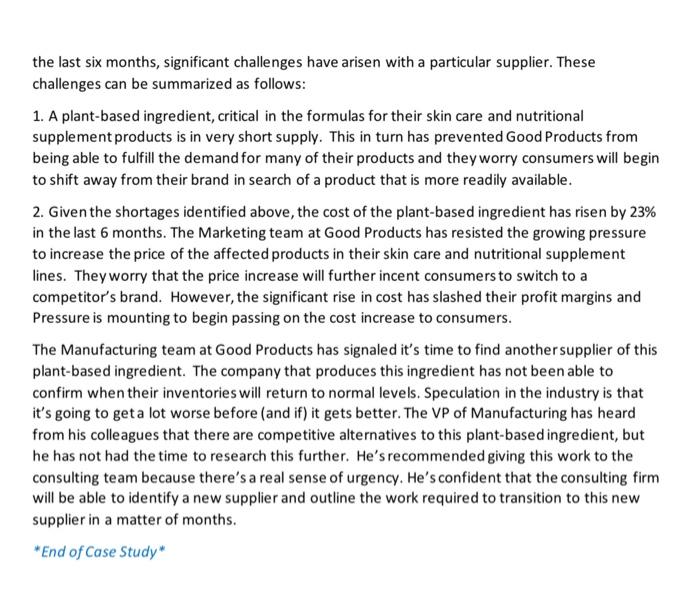
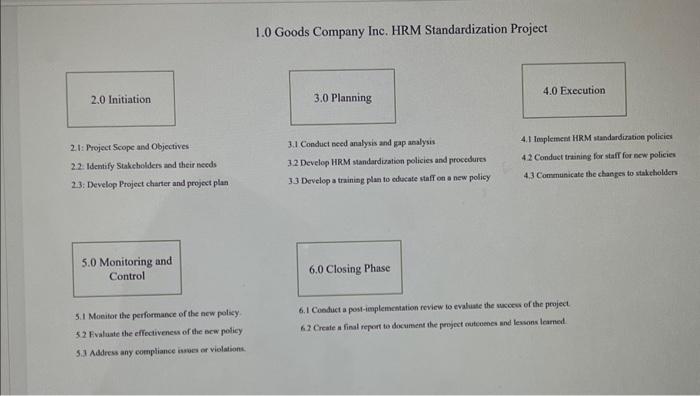
Good Products inc. ("Good Products") is a very successful UK based multinational corporation (MNC) with operations in more than 60 countries and regions. Good Products is a consumer goods corporation that defines its purpose as helping people live healthier lives. They employ over 40,000 people in 6 continents. Since the late 1800 s, Good Products has been widely successful in Europe. In 2018, with a desire to continue their global expansion, they acquired a consumer goods company in New Jersey, USA. Good Products' CEO, Philip Cowell was very proud of his latest acquisition. Integrating this newly acquired company presented many challenges. The American company's information technology systems were quite antiquated. In addition, organizational cultures were very different. Good Products often changed the "rules" in the industry and hired innovative leaders who were not afraid to make mistakes. The Good Products organization was also very skilled at managing change. They were committed to empowering teams to experiment and learn. This was a key success factor behind their continued international growth. On the other hand, the American company was very invested in an accelerating stock price and heavily penalized executives who failed to achieve goals. In addition, the organizational structures of the two companies were very different. Good Products had a product orientation and the American company was highly fragmented along functional lines. This fragmentation often resulted in a lot of departmental conflict. Given the breadth of organizational change required, Good Products hired a management consulting firm to help them successfully complete the integration of the newly acquired American company. Lynne Harris was a project management professional from the management consulting firm. Lynne was asked to put together a plan to implement Good Products' CRM system (Salesforce) into the newly acquired American company's operations. Before beginning this assignment in New Jersey, she spent 3 weeks with Good Products' architecture development team located at the company headquarters in London, England. This gave her an opportunity to review how Salesforce was configured for the Good Products organization. Lynne had just finished a project assignment with Good Products' Home Health Division in France and she was eager to remain with this organization as she had developed many wonderful relationships. Lynne and her former project team received a significant bonus for their success as they finished their last assignment significantly under budget and ahead of schedule. Lynne was confident her success with Good Products would continue and the management consulting firm that employed her was happy to see her take on this new assignment. Lynne was tasked with migrating all of the American company's systems over to the standard Good Products platforms. The first project was the migration of Good Products CRM platform. This would be followed by two additional projects: 1) the standardization of the Human Resources Management (HRM) "system" (policies, processes and technology) and 2) the standardization of the Financial Management "system" (FMS) (policies, processes and technology). With respect to the CRM platform at the newly acquired American company, it was a "home grown" order entry platform and it was not cloud based. This was a real challenge for the sales and service teams as they were largely mobile. This significant shortcoming caused the majority of sales representatives to hold their customer information in their own Excel spreadsheets. This meant that the customer information was very decentralized and out of sync with the American company's official corporate records. In addition, many of departments in the American company operated like independent silos versus an integrated organization. For instance, the American company's Marketing Department struggled to get an accurate picture of current client needs and they got little support from the Sales and Service organization. The Marketing Department's promotional efforts suffered as a result. For instance, most of the email campaigns failed to result in any new sales as almost 40% of the emails "bounced back" as undeliverable. Not having current client information was really impeding sales. Getting the sales representatives to use Global Products' cloud-based CRM system would be very challenging. Aside from the data integration issues, the VP of Sales and Service at the newly acquired American company was a highly independent and competitive individual who was not concerned about the success of other departments. The VP, Roger Coleman, gave his team aggressive targets and he just wanted results. In addition, it was well known that he was not supportive of the company's recent acquisition by Good Products. Roger feared the loss of his independence and worse yet, he assumed that the new CRM system would allow the executives at Good Products to monitor the results of his team and impose additional approval requirements. Rogers thought of all this was unnecessary bureaucracy. In the end, the only thing Roger felt good about was the fact that Lynne Harris would simultaneously report to him and Philip Cowell, the CEO of Good Products. Roger was given the authority to decide which members of his sales and service teams would be "on loan" to the project. Roger made it well known that he would not allow the CRM project to get in the way of his ability to achieve his sales goals. Since his team was struggling to meet their sales targets and this was causing the American company to experience some financial pressures, Roger didn't want any distractions. Lynne knew that this project was going to be challenging. The CEO of Good Products wanted the CRM system to be in place at newly acquired American company within 8 months as he promised his Board a quick and seamless acquisition. A challenge of this magnitude required people with considerable expertise. Lynne was fortunate to have most of the business consultants she worked with on the last project join her on this CRM project. The consulting firm allowed this as Good Products was an important client for the firm. With the sales and service representatives from the American company acting as the end users on the project, Lynne's final step was to get the remaining subject matter experts from the client organizations. She wanted subject matter experts from the UK that were part of the original rollout of the CRM system in Good Products. These subject matter experts were necessary because Lynne would have to oversee a wide range of work on the project. Some of the key aspects of the work include sales and service process redesign, system configuration, business analytics, testing, procedure development, end user training, sales/service job redesign, people change management and implementation. She also asked for an experienced Project Coordinator that could assist her with all the project management deliverables of the project. During one of Lynne's planning sessions with the newly formed international team, she was told the American company's IT managers would impose numerous levels of approvals. After speaking with many of the sales and service representatives in the American company, Lynne learned that the IT department valued tight controls. Lynne was concerned about the controls so she decided to speak to the VP of Sales and Service. Roger was not interested in getting involved. He told her the IT and Sales/Service departments had their own goals and both were struggling to achieve them. They agreed to stay out of each other's way and this was not going to change for this project. Lynne was grateful for this experience, as challenging as it was, because it gave her some early insights into the stakeholder management challenges that await her. Intro to Project Management Case Study-Part 2 Lynne and team successfully migrated the Good Products CRM solution (Salesforce) into the newly acquired American company. With the CRM project completed, it was now time to initiate the standardization of the Human Resource Management (HRM) "system" (policies, processes and technology) and the Financial Management "system" (FMS) (policies, processes and technology). In addition, Good Products decided it was time to address a key issue with their supply chain. Good Products decided to retain Lynne and the management consulting firm to support them on three of these initiatives. They were pleased with the work on the CRM project. In addition, bringing in a new management consulting firm would be very time consuming for everyone involved. Lastly, given the nature of these three projects, it was critical that the project management team had a good understanding of the cultures of the two companies, and this is very hard to "teach" since many elements of culture have to be observed to be appreciated. Human Resource Management Standardization Project The organizational systems in the newly acquired American company were very different than those founds in the UK company. This led to a goal of standardization. In order to gain the buyin of American company's HR team, Philip Cowell, CEO of Good Products, let everyone know he wanted the project management team to look for best practices and put these best practices into place at both companies. This meant that it was possible for best practices to be discovered in the American company and later implemented throughout the UK based organization's various regional offices. However, most people on the project team knew this was nothing more than a kind gesture because the newlyacquired American company's HR practices, policies and systems were perceived to be very ineffective and inefficient. The American company tracked employee satisfaction results and these results validated the HRM challenges. A comparison of the top line employee satisfaction results in both organizations revealed a huge gap. In response to the question "would you recommend this company to members of your professional network and friends", an average of 82% of employees in the UK organization answered "agree" or "strongly agree". However, only 51% of employees in the newly acquired American company answered "agree" or "strongly agree" to a similarly worded question. Sinead O'Sullivan, the HR lead from the CRM project, skimmed the comments from survey participants and she noticed two themes: 1) lack of clarity around job responsibilities was leading to employee frustration and 2) the belief that employees were not paid what they were worth relative to the market and their peers inside the company was leading to a sense of inequity. Lynne realized that she would need to recruit a team of experienced HR professionals from the management consulting firm. Lynne's partner at the management consulting firm confirmed Sinead O'Sullivan would be assigned to this project. This was terrific news, and she hoped a few more consultants like Sinead would become available soon. In addition, Lynne asked Philip's executive team to identify at least 5 HR representatives from the UK and American companies. Lynne spoke with Philip about this as she needed to ensure the representatives would be employee focused and very knowledgeable of HR best practices. Lynne wanted the best and the brightest to join her team. As Lynne began to think about the work required on this project, she knew that a comprehensive assessment of the HR policies, processes and technology in the UK and American companies would be time-consuming but critical. If done well, it would allow the team to deliver outstanding recommendations in support of the standardization goal. Financial Management Standardization Project Philip Cowell, CEO of Good Products, was all too familiar with the financial management challenges at the American company. During the acquisition process, he poured over the American company's financial statements in an attempt to assess true profitability. He found the financial statements very challenging to comprehend. Philip asked his CFO, Isla Johnson, to work with the CFO of the newly acquired American company and produce a report summarizing the financial health of the American company. 2 weeks into this assignment, Isla informed Philip that the work was not going well. The American CFO "carried a cloud of mystery" and was rarely able to produce information when it was needed. Eventually, the financial health report was produced but it offered Philip little insights. Afterseveral meetings with the American company's CFO, Philip decided he needed to replace this individual with someone who would offer objective perspectives and help the organization embrace the digital technologies currently used throughout the Good Products organization. Just before the project'skick-off meeting, Philip announced his choice for CFO at the newly acquired American company. In a bold move, he appointed Isla Johnson to serve in the position for a transition period of 2 years. Philip promoted a member of Isla's management team to take her place while she held the CFO position at the American company. Once the integration of the newly acquired American company was complete, the accounting and finance professionals in the US would continue to report to Isla but she would return to the UK and resume leadership as the CFO for all Good Products' global operations. Isla was very helpful to Lynne Harris throughout the Financial Management Standardization Project. They shared the same objectives: 1) restore integrity to the American company's financial management "system" and 2) implement digital technologies in order to automate financial management processes. Lynne was grateful that Claude Julien, her finance lead on the CRM project, was available to work on this project. Claude had been with the management consulting firm for many years, and he was known for his wit and zany sense of humour. He would be a huge asset to the team. Isla Johnson worked with Lynne and Claude to identify finance professionals from Good Products and the American company who would be well suited for this project. As Lynne began to think about the work required for this project, she was excited about introducing SAP's financial management system to the American company as it was working so well for Good Products. Further, it was clearly a better solution than the "home grown" thick client platform that the American company was currently using as this platform was not cloud based and was the source of many operating inefficiencies. Isla was the champion of the SAP software selection decision as CFO for Good Products so Lynne knew she would be fully supportive of the standardization work that lie ahead. Claude was excited about creating a roadmap for the introduction of other digital technologies like artificial intelligence (Al) and blockchain as they would help address the existing pain points in the American company. A few of the pain points included: 1. financial forecasts rarely hit the mark with an acceptable level of accuracy 2. quarter end close was very time-consuming and reporting was rarely available before Day 15 of the new quarter 3. administering vendor payments was highly manual despite the fact that almost 70% of the American company's vendors had long standing contracts for the supplies, materials and equipment they provided. In sharing these pain points with Lynne, Claude could barely contain his excitement - he has tackled these financial management challenges in the past and the results with the American company will be nothing but truly impressive. Seasoned consultants like Claude knew that a comprehensive assessment of current state policies, processes and technology is a critical part of any financial management standardization project. If done well, these assessments would allow the team to deliver outstanding recommendations. Lynne loved working with management consultants like Claude as they are so refreshing - the more challenging the project the more excited they got. This was due in part to the fact that they know the experience they gain on projects like this will help them to secure great project assignments for many years to come. New Supplier Selection Project Good Products has a very successful line of health care products that have attracted global consumer attention. In particular, they are very proud of their skin care line that targets the aging population. This line, coupled with the very successful brand of nutritional supplements that they also sell globally has delivered impressive results over the last five years. However, in the last six months, significant challenges have arisen with a particular supplier. These challenges can be summarized as follows: 1. A plant-based ingredient, critical in the formulas for their skin care and nutritional supplement products is in very short supply. This in turn has prevented Good Products from being able to fulfill the demand for many of their products and they worry consumers will begin to shift away from their brand in search of a product that is more readily available. 2. Given the shortages identified above, the cost of the plant-based ingredient has risen by 23% in the last 6 months. The Marketing team at Good Products has resisted the growing pressure to increase the price of the affected products in their skin care and nutritional supplement lines. They worry that the price increase will further incent consumers to switch to a competitor's brand. However, the significant rise in cost has slashed their profit margins and Pressure is mounting to begin passing on the cost increase to consumers. The Manufacturing team at Good Products has signaled it's time to find another supplier of this plant-based ingredient. The company that produces this ingredient has not been able to confirm when their inventories will return to normal levels. Speculation in the industry is that it's going to get a lot worse before (and if) it gets better. The VP of Manufacturing has heard from his colleagues that there are competitive alternatives to this plant-based ingredient, but he has not had the time to research this further. He's recommended giving this work to the consulting team because there's a real sense of urgency. He's confident that the consulting firm will be able to identify a new supplier and outline the work required to transition to this new supplier in a matter of months. 1.0 Goods Company Inc. HRM Standardization Project 4.0 Execution 2.0 Initiation 3.0 Planning 21: Project Scope and Objectives 3.1 Conduct seed analysis and pap analywis 4.1 lomplenemt HRM uandardination policio 22. Identify Stakcholdes and their needs 3.2 Develop HRM standardization policies and procedurs 42 Conduct training for staff for new policies 23: Develop Project charter and project phan 33 Dovelop a training dan to educate tuff on a new policy 4.3 Communicate the changes to stakdiolden 5.0 Monitoring and Control 6.0 Closing Phase 5.1 Moeitot the performance of the acw policy 6.1 Conduct a pos-implememation review lo evaluate the uxcecs of the project 52 Fvaluate the effeciveness of the BCw policy 62 Crate a final repert to documene the probject mutsones and lenons lamed 5.3 Address any compliance iswes or violations
